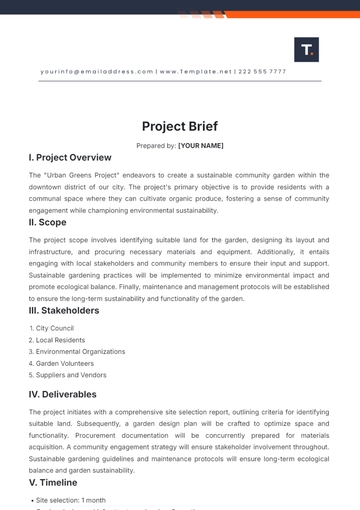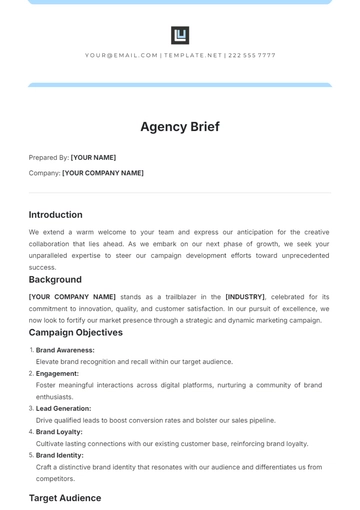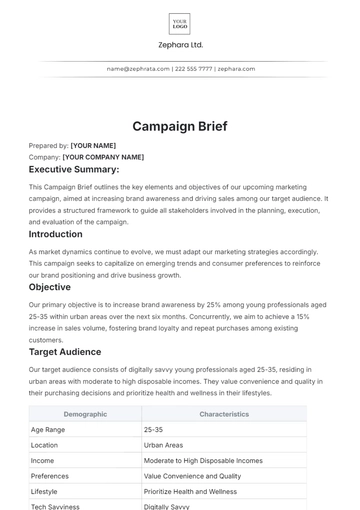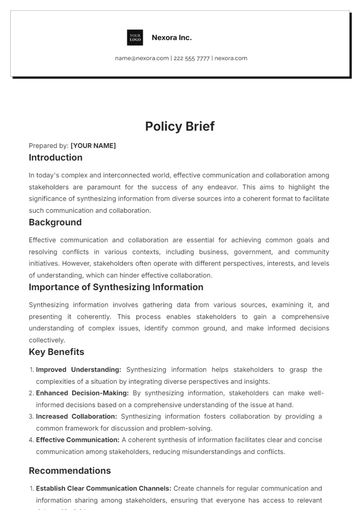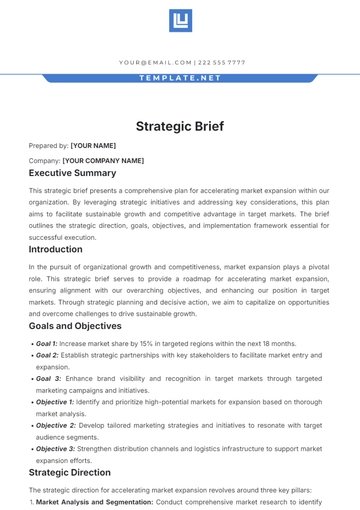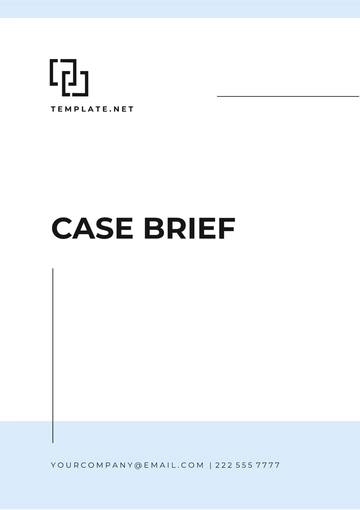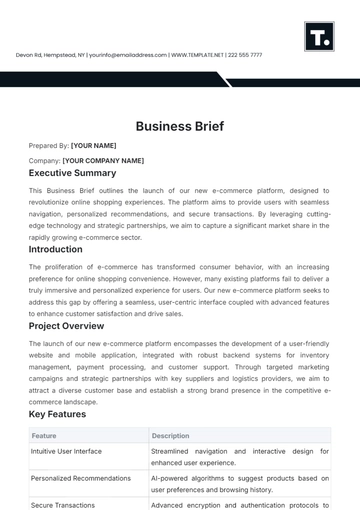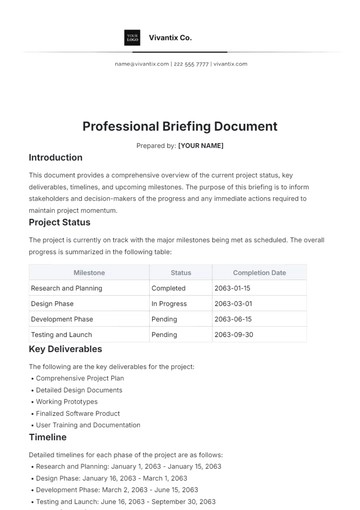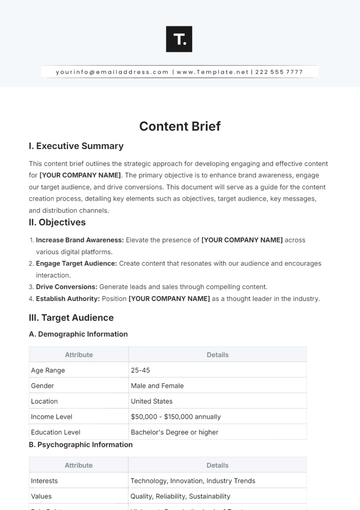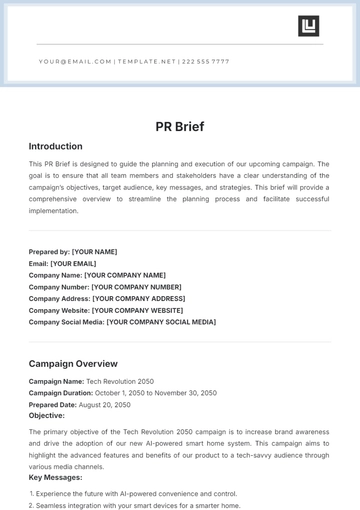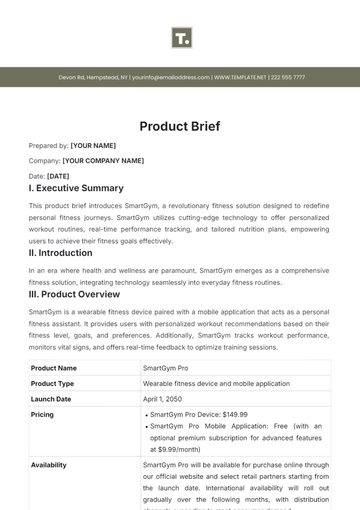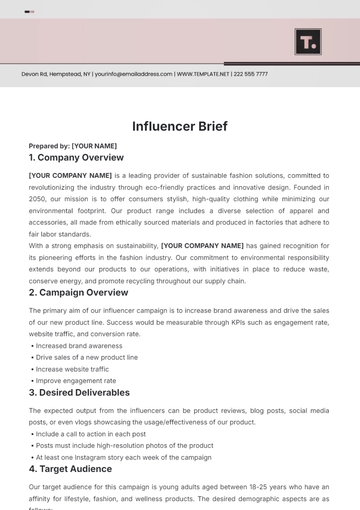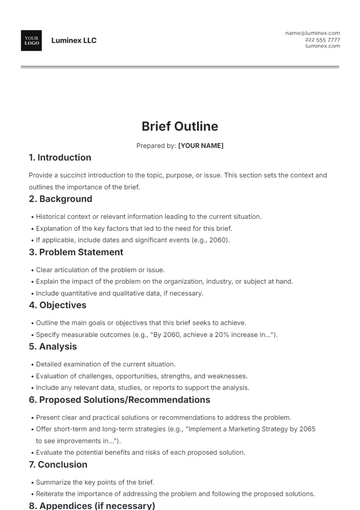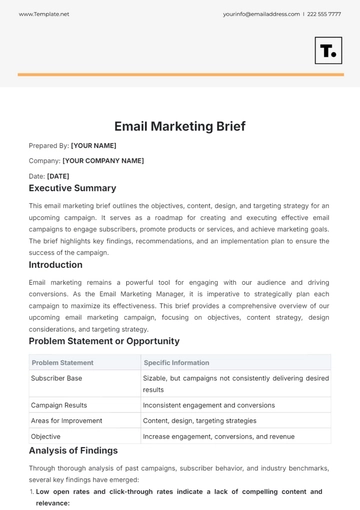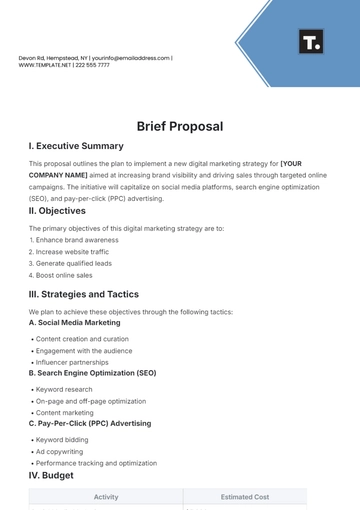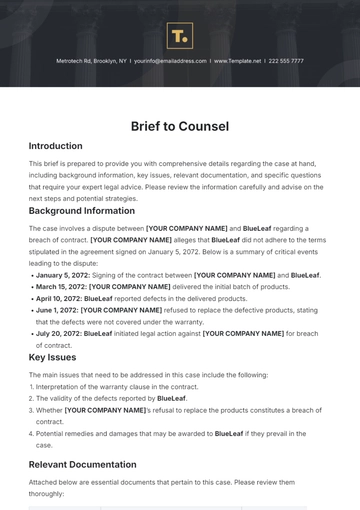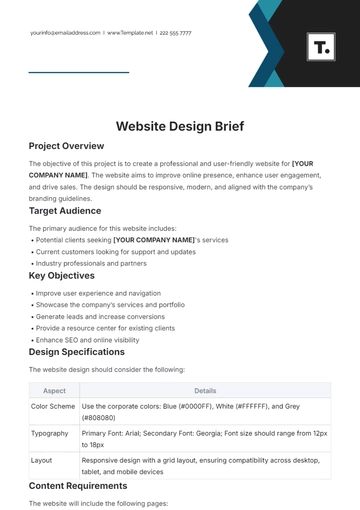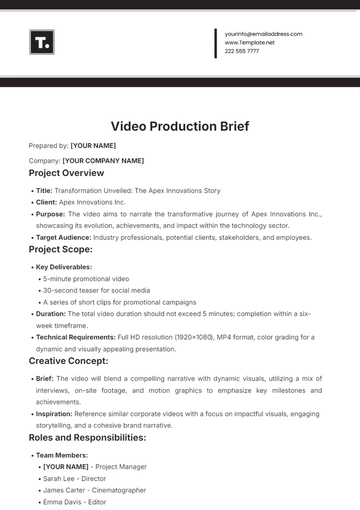Free Tax Incentive Identification Brief
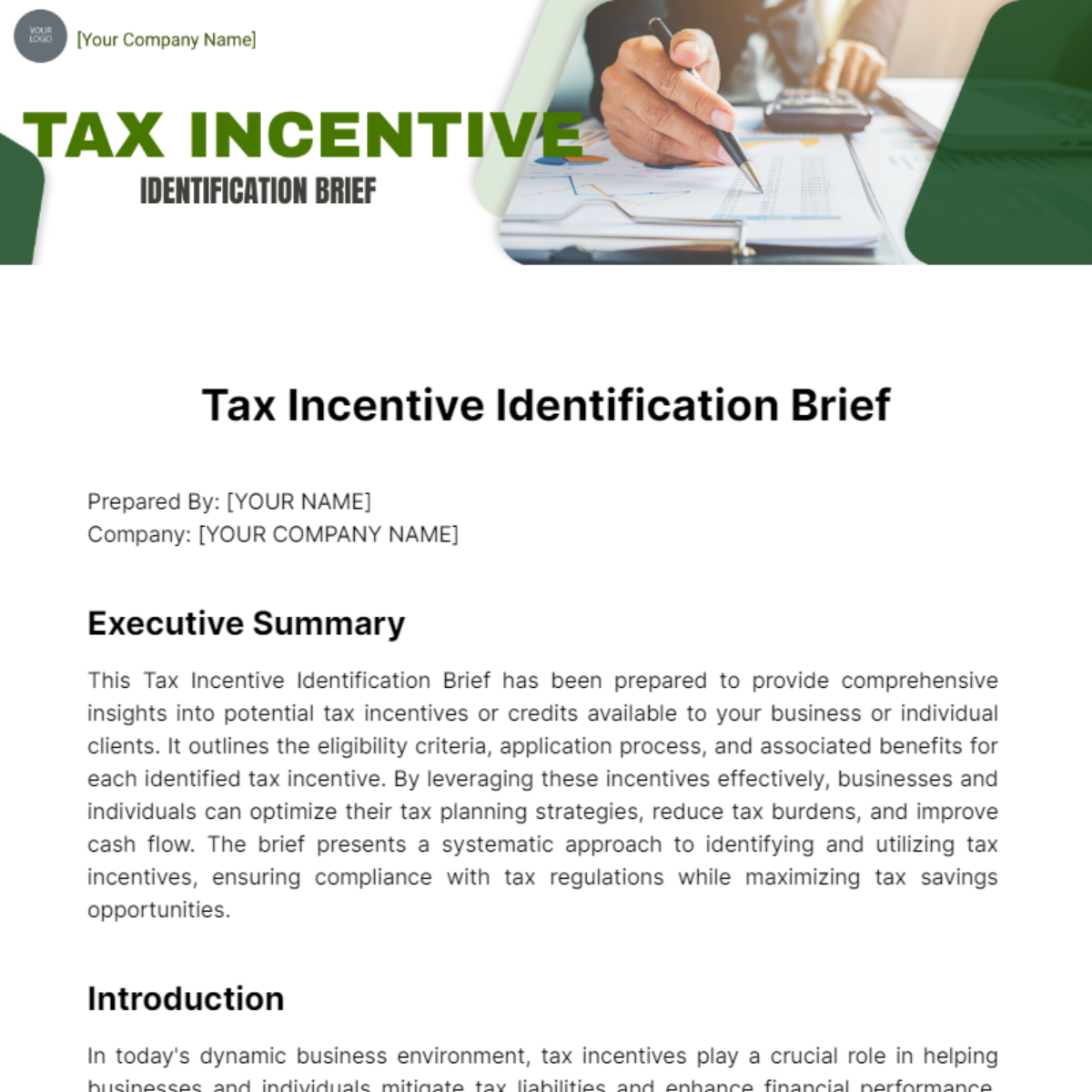
Prepared By: [YOUR NAME]
Company: [YOUR COMPANY NAME]
Executive Summary
This Tax Incentive Identification Brief has been prepared to provide comprehensive insights into potential tax incentives or credits available to your business or individual clients. It outlines the eligibility criteria, application process, and associated benefits for each identified tax incentive. By leveraging these incentives effectively, businesses and individuals can optimize their tax planning strategies, reduce tax burdens, and improve cash flow. The brief presents a systematic approach to identifying and utilizing tax incentives, ensuring compliance with tax regulations while maximizing tax savings opportunities.
Introduction
In today's dynamic business environment, tax incentives play a crucial role in helping businesses and individuals mitigate tax liabilities and enhance financial performance. This Tax Incentive Identification Brief serves as a valuable resource for consultants seeking to assist their clients in identifying and leveraging available tax incentives effectively. By understanding the various incentives offered by tax authorities and government agencies, consultants can provide tailored guidance to support their clients' strategic objectives and financial goals.
Tax Incentives Overview
Tax Credits: Tax credits directly reduce the amount of tax owed by taxpayers. They can be either refundable or non-refundable. Refundable tax credits allow taxpayers to receive a refund if the credit exceeds their tax liability, while non-refundable tax credits only reduce tax liability to zero but do not result in a refund. Common examples of tax credits include:
Research and Development (R&D) Tax Credits: Offered to businesses that engage in qualified research activities to encourage innovation and technological advancement.
Renewable Energy Tax Credits: Provided to individuals or businesses that invest in renewable energy systems, such as solar or wind power, to promote sustainable energy sources.
Low-Income Housing Tax Credits: Aimed at developers and investors who finance affordable housing projects to address housing needs in low-income communities.
Deductions: Tax deductions allow taxpayers to reduce their taxable income, thereby lowering their overall tax liability. Deductions are typically available for specific expenses incurred by businesses or individuals. Common deductions include:
Business Expenses Deductions: Allowable deductions for ordinary and necessary expenses incurred in the course of conducting business activities, such as salaries rent, utilities, and supplies.
Education Expenses Deductions: Deductions for qualified education expenses, such as tuition, fees, and textbooks, to support lifelong learning and skill development.
Healthcare Expenses Deductions: Deductions for qualifying medical expenses, including health insurance premiums, prescription medications, and medical services, to alleviate the financial burden of healthcare costs.
Exemptions: Tax exemptions exclude certain types of income or activities from taxation altogether, resulting in a reduction in overall tax liability. Exemptions may be granted for specific industries, transactions, or entities to stimulate economic growth or achieve social objectives. Examples of tax exemptions include:
Foreign Income Exclusion: Exempts certain types of foreign income earned by U.S. citizens or residents working abroad from U.S. taxation to prevent double taxation and encourage international business activities.
Nonprofit Organization Exemption: Exempts qualifying nonprofit organizations from paying taxes on income generated from charitable activities, donations, and fundraising efforts to support their philanthropic missions.
Grants and Subsidies: Governments may offer grants or subsidies to businesses, organizations, or individuals to support specific projects, initiatives, or investments. Grants and subsidies provide financial assistance without the requirement of repayment and can be utilized for various purposes, such as:
Economic Development Grants: Provided to businesses or communities to stimulate economic growth, create jobs, and improve infrastructure in underserved areas.
Research Grants: Funding awarded to researchers, scientists, or academic institutions to conduct research and development projects in priority areas, such as healthcare, technology, or environmental conservation.
Agricultural Subsidies: Payments or assistance provided to farmers or agricultural producers to stabilize crop prices, ensure food security, and promote sustainable farming practices.
Common Use Cases
Tax incentives can be utilized in various scenarios to achieve specific objectives, such as:
Assisting businesses: Tax incentives help reduce tax burdens and improve cash flow, such as R&D tax credits or investment tax credits for capital assets.
Supporting decisions: Incentives influence investment strategies, expansions, or relocations by offering favorable tax treatment in specific industries or regions.
Guiding individuals: Tax-advantaged accounts like IRAs aid retirement planning, while homeownership incentives encourage wealth accumulation through deductions.
Ensuring compliance: Tax professionals navigate eligibility and documentation requirements, ensuring clients adhere to regulations while claiming incentives.
Facilitating discussions: Professionals engage with tax authorities to optimize the utilization of incentives, supporting business growth and economic development efforts.
Identification Process
The identification process for tax incentives involves comprehensive research, analysis, and consultation with tax experts. Key steps in the identification process include:
Conducting a thorough review of applicable tax laws, regulations, and administrative guidance
Analyzing business operations, investments, and financial activities to identify potential eligibility for tax incentives
Consulting with industry experts, tax advisors, or government agencies to gain insights into available incentives and eligibility criteria
Documenting findings and recommendations to guide decision-making processes and facilitate the application process for tax incentives
Analysis of Potential Benefits
The potential benefits associated with identified tax incentives are diverse and impactful:
Reduction of Taxable Income: Incentives often allow for deductions or exemptions, lowering taxable income. For instance, R&D tax credits reduce taxes by deducting qualified expenses.
Direct Tax Savings: Credits and incentives directly reduce tax liabilities. For example, investment tax credits offer businesses direct reductions based on qualified investments.
Enhanced Cash Flow: Some incentives defer tax payments or accelerate deductions. Accelerated depreciation and tax deferral strategies, like like-kind exchanges, improve cash flow by reducing immediate tax burdens.
Increased Competitiveness and Profitability: By strategically using incentives, businesses can lower costs and invest more in growth initiatives, improving competitiveness. Individuals can also benefit by strategically using incentives to support financial goals like education or homeownership.
Eligibility Criteria
Eligibility criteria for tax incentives are contingent upon several factors that dictate the qualification of businesses or individuals for specific incentives. Understanding these criteria is pivotal for ensuring successful applications and claiming incentives. Below is a breakdown of common eligibility requirements:
Type of Business or Industry: Certain tax incentives are tailored for particular industries or types of businesses. For instance, research and development tax credits might be specifically aimed at companies engaged in innovative research activities, while energy efficiency incentives may be geared towards businesses involved in sustainable energy production or conservation efforts.
Size of the Investment or Expenditure: Many tax incentives have thresholds related to the scale of investments or expenditures. This could involve minimum investment amounts in equipment, infrastructure, or research and development activities. Conversely, some incentives may have caps on the maximum allowable investment or expenditure to qualify.
Location of the Business or Project: Location-based incentives are often tied to geographical areas designated for economic development purposes, such as enterprise zones, opportunity zones, or regions facing economic challenges. Businesses or projects situated in these designated areas may be eligible for tax breaks or incentives aimed at stimulating growth and investment in those areas.
Compliance with Specific Performance or Activity Requirements: Some tax incentives require businesses or individuals to meet specific performance targets or engage in qualifying activities to be eligible. For example, job creation incentives may necessitate the creation of a certain number of new jobs within a specified timeframe, while investment tax credits may require investments in qualified assets or infrastructure.
Documentation of Expenses, Activities, or Investments Related to the Incentive: Documentation is critical for substantiating eligibility for tax incentives. Businesses or individuals seeking to claim incentives must maintain thorough records of relevant expenses, activities, or investments related to the incentive. This documentation typically includes receipts, invoices, contracts, payroll records, and other supporting documents that demonstrate compliance with eligibility requirements.
Documentation Requirements
Documentation requirements for claiming tax incentives vary depending on the specific incentive and the jurisdiction in which it is being claimed. However, here is a more detailed breakdown of the typical documentation requirements:
Financial Records:
Income Statements: Detailed records of a business's revenue, expenses, and profits over a specific period.
Balance Sheets: Statements showing a business's assets, liabilities, and equity at a particular point in time.
Tax Returns: Completed tax forms filed with the relevant tax authority, detailing income, deductions, credits, and tax liabilities.
Investment Documentation:
Receipts: Proof of payment for eligible investments or expenditures related to the incentive.
Invoices: Itemized bills or invoices for goods purchased or services rendered, directly related to the incentive.
Contracts: Formal agreements outlining terms and conditions of investments or projects qualifying for the incentive.
Employment Data:
Payroll Records: Records of wages, salaries, bonuses, and other compensation paid to employees.
Employee Information: Details of employees, including names, social security numbers, positions, and hours worked, if applicable.
Application Forms and Supporting Documentation:
Specific Forms: Official forms provided by the tax authorities or government agencies responsible for administering the incentive.
Supporting Documentation: Additional documents are required to support the application, such as business plans, project descriptions, or proof of eligibility criteria met.
Compliance Considerations
When leveraging tax incentives, adherence to tax regulations is paramount to avoid penalties and ensure the legitimacy of incentive claims. Below are specific details regarding compliance considerations:
Understanding Reporting Obligations and Deadlines: It's crucial to comprehend the reporting requirements and deadlines associated with claiming tax incentives. Failure to submit required reports or missing deadlines can result in the forfeiture of incentives or imposition of fines. Detailed guidelines provided by tax authorities or government agencies should be followed meticulously to meet reporting obligations promptly.
Maintaining Accurate Records and Documentation: Accurate record-keeping is indispensable for supporting incentive claims and demonstrating compliance with eligibility criteria. Documentation such as financial records, receipts, contracts, and application forms should be organized and retained in an orderly manner. These records serve as evidence of expenses, investments, or activities related to the incentive and may be requested during audits or inquiries by tax authorities.
Monitoring Changes in Tax Laws and Regulations: Tax laws and regulations are subject to frequent updates and revisions, which may impact the eligibility or benefits associated with tax incentives. It's imperative to stay informed about changes in tax legislation through regular monitoring of official announcements, publications, and professional advisories. Proactive measures should be taken to assess the implications of regulatory changes on existing incentive strategies and to adjust compliance practices accordingly.
Addressing Potential Audit Risks: Tax authorities may conduct audits or inquiries to verify the accuracy and validity of incentive claims. It's essential to anticipate and address potential audit risks by maintaining thorough documentation, adhering to compliance requirements, and implementing internal controls to ensure the integrity of incentive-related data. In the event of an audit or inquiry, prompt cooperation with tax authorities and the provision of requested information can facilitate the resolution of any discrepancies or concerns.
Recommendations
Based on the analysis of identified tax incentives and their potential benefits, the following recommendations are provided:
Prioritize Incentives for Maximum Tax Savings: Evaluate each identified tax incentive based on its potential tax savings and alignment with strategic objectives. Focus on incentives that offer substantial financial benefits while aligning with the long-term goals of the business or individual client. Consider factors such as eligibility criteria, application complexity, and potential return on investment when prioritizing incentives for utilization.
Develop a Comprehensive Claiming Plan: Create a detailed plan outlining the steps for claiming and maximizing available tax incentives. This plan should include a timeline for application submissions, documentation requirements, and responsibilities assigned to relevant team members or stakeholders. Ensure that the claiming plan is aligned with compliance requirements and strategic objectives to optimize the utilization of available incentives.
Establish Effective Documentation Processes: Implement robust processes and procedures for documenting eligibility and supporting incentive claims effectively. This includes maintaining accurate records of expenses, investments, and activities related to each incentive. Develop standardized templates and tools to streamline the documentation process and ensure consistency in record-keeping practices. Regularly review and update documentation procedures to adapt to changes in tax regulations and reporting requirements.
Monitor Tax Law Changes and Regulatory Updates: Stay vigilant about changes in tax laws and regulations to identify new opportunities or risks associated with existing incentives. Establish a system for monitoring updates from tax authorities, legislative bodies, and industry publications to stay informed about changes that may impact the availability or benefits of tax incentives. Proactively assess the implications of these changes on existing tax planning strategies and adjust claiming plans accordingly to optimize tax savings opportunities.
Conclusion
In conclusion, this Tax Incentive Identification Brief serves as a valuable tool for consultants seeking to assist their clients in optimizing tax planning strategies and maximizing tax savings opportunities. By understanding the eligibility criteria, application process, and benefits associated with various tax incentives, businesses, and individuals can make informed decisions to achieve their financial goals while ensuring compliance with tax regulations. Effective utilization of tax incentives can lead to improved cash flow, enhanced competitiveness, and sustained business growth in today's dynamic tax landscape.
- 100% Customizable, free editor
- Access 1 Million+ Templates, photo’s & graphics
- Download or share as a template
- Click and replace photos, graphics, text, backgrounds
- Resize, crop, AI write & more
- Access advanced editor
Introducing the Tax Incentive Identification Brief Template from Template.net: your essential tool for maximizing tax benefits. This customizable and editable template streamlines incentive identification, ensuring accuracy and efficiency. With our Ai Editor Tool, effortlessly tailor every detail to suit your tax strategy. Simplify incentive tracking and elevate your tax planning with ease, exclusively on Template.net.


